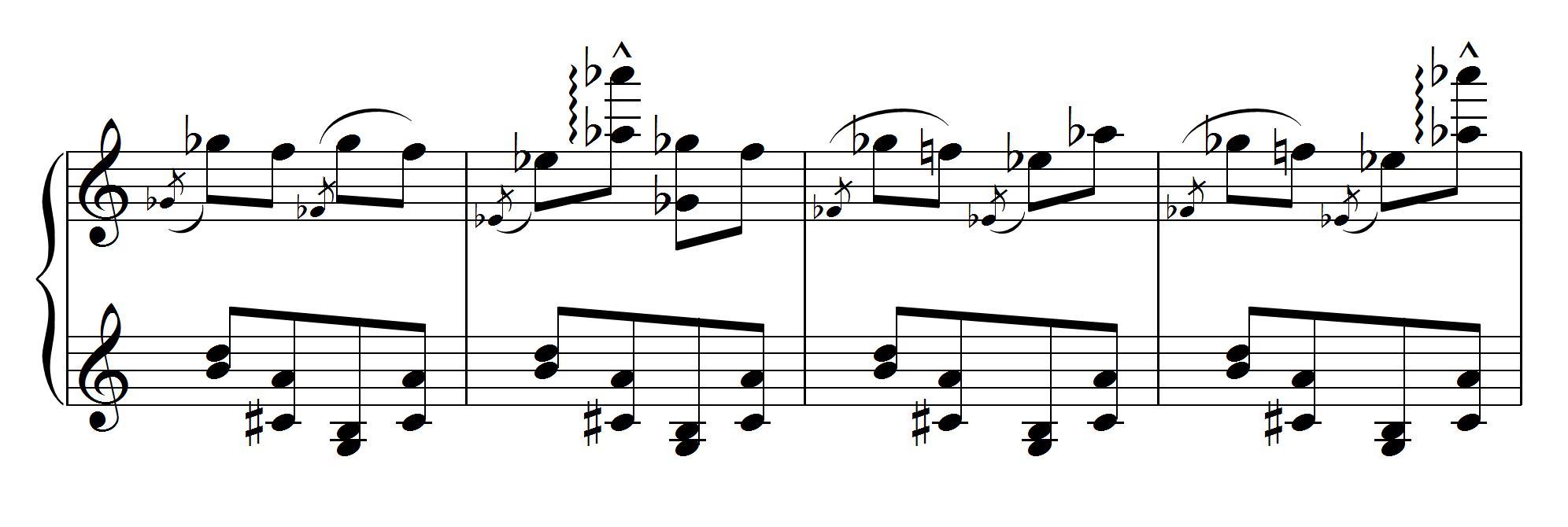“Eventually the left must play both the sustained bass note and moving quarter note line, but the right hand can help at the start to ensure a clean performances of the grace notes.”
Submitted by Michael Clark
Published on 1/1/2020

“Eventually the left must play both the sustained bass note and moving quarter note line, but the right hand can help at the start to ensure a clean performances of the grace notes.”
Submitted by Michael Clark
Published on 1/1/2020
Original:

Suggested performance:

“The F-flat grace notes in mm. 105–6 are extremely awkward when played in the right hand. Catching them with left-hand 5 eliminates the crowding.”
Submitted by Michael Clark
Published on 2/13/2022
Original:

Suggested performance:

“Redistributing the notes in m. 110 eliminates an awkward hand crossing and allows the right hand to remain in a closer position to the succeeding octaves.”
Submitted by Michael Clark
Published on 1/1/2020


“Taking the B-flat from the lower staff into the right hand in m. 158 is the only way I can manage the awkwardness of this measure. When possible, taking the grace notes in the left hand facilitates a stronger sforzando on the arrival note.”
Submitted by Michael Clark
Published on 1/1/2020
Original:

Suggested performance:

“The B-flat grace note in m. 220 is extremely awkward when played in the right hand. Catching it with finger 5 in the left hand eliminates the crowding.”
Submitted by Michael Clark
Published on 1/1/2020

“Taking the grace notes in the left hand facilitates a smooth transition between registers.”
Submitted by Michael Clark with thanks to Robert Roux
Published on 1/1/2020

“Taking the F in the right hand allows the left-hand arpeggio to follow the same fingering pattern as the pervious one and gives more control of the timing.”
Submitted by Michael Clark
Published on 1/1/2020

“Dividing the grace notes this way helps me get a bright and clear sound at the top. Taking some of the lower notes on the top staff into the left hand facilitates clear voicing and reduces position shifts.”
Submitted by Michael Clark
Published on 9/1/2023

“The left hand can assist with a few notes to allow the right hand to start the trill with an optimal fingering.”
Submitted by Michael Clark
Published on 9/8/2023

“These redistributions help me project the melody in this complex passage. Taking the tenor B-flat on the downbeat of m. 63 with the right-hand thumb eliminates the need to roll that chord. I play the left-hand grace notes with the right-hand A-flat on beat two to facilitate a clean pedal change for the A-flat major harmony.”
Submitted by Michael Clark
Published on 9/1/2023

“These redistributions help to clearly voice the melody and facilitate swift and smooth grace notes in m. 68.”
Submitted by Michael Clark
Published on 9/1/2023
Original:

Possible rhythm of grace note and rolled chord:

“In this fingering, the right-hand thumb takes the top F in the bass clef, allowing the left hand slightly more time to leap to the top note. This redistribution keeps the exciting choreography of the hand crossing while allowing for a more secure delivery.”
Read more about how I arrived at this fingering.
Submitted by Michael Clark
Published on 10/4/2020

“Splitting up this accompaniment (and the grace notes in particular) between the hands allows an even stronger, more pesante delivery.”
Submitted by Michael Clark with thanks to Jennifer Hayghe
Published on 1/1/2020

“Redistributing these grace notes as indicated above allows for a stronger left-hand fingering and sets up a serviceable hand-over-hand fingering on the descending arpeggio.”
Submitted by Michael Clark
Published on 1/10/2020

“Taking the top of the left roll as an octave eliminates a fingering crossing, resulting in a more secure delivery.”
Submitted by Michael Clark
Published on 1/1/2020